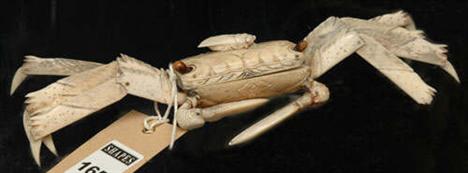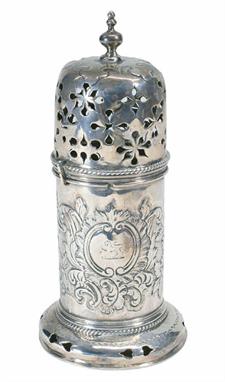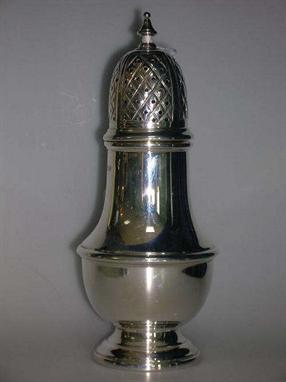We found 116099 price guide item(s) matching your search
There are 116099 lots that match your search criteria. Subscribe now to get instant access to the full price guide service.
Click here to subscribe- List
- Grid
-
116099 item(s)/page
A 17th Century sugar caster, of cylindrical shape (embossed and crested at a later date) with pierced skirt base, the pierced cover with cable border, cut card decoration and finial, having a bayonet fitting, 18.5cm (7.25") high, no date letter, the base with two maker’s marks I W above a star and I W below a crown (see Jackson pages 126 and 139), the cover not marked
An unusual, fine quality, 19c German hunting knife by C.A.STAHLE Stuttgart, both surfaces of the 13" blade etched with hunting scenes of deer, hounds and pheasants in a wooded landscape, the hilt in the form of a pair of deer hooves and a shell, the antler handle with acorn finial, the orig leather and steel scabbard with belt hook, museum quality G++(400-600)
A Regency period rosewood lady's writing desk the whole decorated with inset glass 'decoupage' panels depicting a courting couple flanked by birds, flowers, insects and vignettes of cavorting cupids, the top section with balustraded gallery and 'secret' finial release catch to open a pair of central doors enclosing stationery racks, bounded by six short drawers opening with hidden button release catches, the tooled skiver above a full width frieze drawer on turned and fluted tapering front legs 88cm wide, 133cm high, 52cm deep
An early 18th century steel mounted Italian flintlock holster pistol the rounded banana shaped lock with finely chiselled acanthus leaf at the tail and on the frizzen back, rubbed signature Anton Boniscolo, elegant shaped cock with floral chiselled cock retaining screw head, trigger cut and scrolled with foliate chiselling, replacement trigger guard, bulbous spurred pommel with chiselled acanthus leaves on both sides and floral butt cap en suite with cock retaining screw, pierced and cut steel blank escutcheon, finely cut foliate side plate, the two stage barrel octagonal at the breech tapering to a slender muzzle with rubbed classical portrait head at the breech, plain tang, dark walnut full stock carved with foliate scrolls at the barrel tang, trigger guard finial and rear chiselled steel ramrod pipes, replacement ramrod 53cm long
An Irish large bore late 18th century flintlock travelling pistol the flat engraved stepped lock signed CLARKE, semi rain proof pan and friction roller, plain barrel tang with engraved line at the false breech, the octagonal barrel [minor corrosion] signed CLARKE DUBLIN on the top flat, full walnut stock with plain butt and silver tear drop butt cap, plain steel trigger guard with pineapple finial, ram-rod pipes with original horn tipped ram rod 25.5cm long
A 19th century percussion travelling pistol the back action lock engraved with foliate scrolls and signed POWELL SHEFFIELD engraved barrel tang and trigger guard, with pineapple finial the octagonal barrel with silver line at the false breech and silver bead fore sight, blank silver escutcheon and silver barrel bolt escutcheons full walnut stock with chequered butt (in the manner of Durs Egg) steel ramrod pipe and captive swivel ramrod 28cm long
A 19th century percussion travelling pistol the hammer and back action lock engraved with foliate scrolls and signed LACEY & Co, engraved barrel tang and trigger guard with pineapple finial the octagonal barrel engraved at the false breech and LONDON on the top flat, silver bead foresight, blank silver oval escutcheon and silver barrel bolt escutcheons, full walnut stock with chequered butt [in the manner of Durs Egg], steel ramrod pipe and captive swivel ramrod 25.5cm long Note: J.C. Lacy were in business in 1810 at 63 Threadneedle Street London in 1826 the firm was Lacy & Co.
A George III period mahogany longcase clock the twin train movement with anchor escapement striking the hours on a bell, the swan neck pediment with eagle finial above an arched brass dial signed Thos. Spence, Dysert (sic.) to the arch, with roman and arabic chapters, the matted centre with subsidiary seconds and calendar dials, between rococo-cast spandrels, the case with fluted quadrant corners above a plinth base, on bracket feet, the whole decorated with flower-filled urns, rosettes and shell paterae 211cm high
A William IV silver three bottle inkstand, by Robert Hennell II, London 1830, the rectangular base within a gadrooned edge mounted with three square pierced gadroon edged galleries each containing a plain glass bottle, two with circular unmarked pierced covers flanking a third with square silver top (marked as the frame) with rose finial, each side of the stand with a pen depression each engraved with an armorial, 24cm wide, 20.75oz (weighable)
A George III silver tea caddy, maker G.S (see Jackson p.214), London 1790, of oval shape with domed flush hinged cover with vase finial, the body engraved with bright cut bands and festoons around two cartouches each engraved with a crest and an armorial respectively, has lock but no key, 13.25cm high, 10.25oz
A George III silver mustard pot, by Hester Bateman, London 1783, of plain drum shape with beaded edges below a high domed cover with vase finial, scroll handle and with a blue glass liner, crested, 6cm diameter; together with a later fiddle pattern mustard spoon by Joseph Taylor, Birmingham 1813, 12cm, 3.75oz (2)
A Victorian silver four piece tea set, by Alexander Smith, London 1868/71, comprising: a teapot of pear shape, raised on four scrolled foliate feet, the body embossed with scrolls and flowers below a beaded edge, the flat domed hinged cover with beaded finial and with a beaded insulated handle, monogrammed, 18.5cm high, together with the matching hot water jug, 22.5cm high, large sugar bowl, 12.5cm diameter and companion milk jug, 12.5cm high, 61oz (4)
A 19th century Tunbridgeware hexagonal caddy, the walnut domed lid with a ball finial, the sides inlaid cube parquetry panels, the plinth base with chevron banding, 20cm (8in) high, 11cm (4.25cm) wide. Dr Ian Beavis of the Tunbridge Wells museum has suggested that caddies of this type might be from the workshop of the Nye family.
-
116099 item(s)/page















































